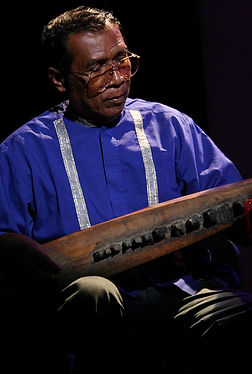
Samaon Sulaiman
A GAMABA Artist Exhibit

Mamayog: the Music of Samaon Sulaiman, a series of audio recordings with a book containing more than 300 pages of transcriptions of these recordings and a biography about the Maguindanaon kutyapi, was produced by the Gawad sa Manlilikha ng Bayan a year after he died.
Works
The NCCA authorized the first phase of Manlilikha ng Bayan Samaon Sulaiman's three-part project, "Documentation of the Different Modes of Traditional Maguindanao Music Based on the Kutyapi," in mid-2009. Manlilikha ng Bayan Samaon Sulaiman completed the audio recording of the two variations of Maguindanao music played on the kutyapi in only three days in November 2009: 10 musical pieces in the "dinaladay" (gentle) mode and 12 musical pieces in the "binalig" mode, with Mr. Sulaiman providing the translation of each musical piece.The "dinaladay" are old Maguindanao music lyrics played on the kutyapi with the customary arrangement of beeswax frets. The more current "binalig" is an improvised "dinaladay" performed faster with a different fret arrangement. This kutyapi phrase is used by kulintang performers to refer to a new style of playing.
Kutyapi Music
"Mamayog," a set of audio recordings and a 300-page book including transcriptions of these recordings as well as a monograph about the Maguindanaon kutiyapi.The recordings and book pay tribute to Filipino traditional musicians' inventiveness as well as Samaon Sulaiman's final contribution to the Filipino people.
Mamayog
The Instrument

Kutyapi
The kutiyapi, also called the kudyapi, is a two-stringed boat lute from the Philippines. There are some name variants depending on where it is utilized. This instrument was known as 'kutiapi' in Maguindanao, 'kotyapi' in Maranao, and 'kotapi' in Subanon. The Tiruray people termed it 'fuglung or faglong.' A similar instrument known as kacapi is also played in Southeast Asia. It shared the same name, although the kacapi is a zither instrument and not a lute.
The kudyapi, as it is usually known, is a four to six foot long instrument with nine frets constructed of hardened beeswax. It is made of softwood, similar to that of the jackfruit tree. Surprisingly, the Maguindanao people's lone stringed instrument is the kudyapi. However, it is one of the most frequent instruments among several ethnic communities, such as the Manobo and the Maranao. A continual monophonic effect is performed with one string, as is the case with all kutiyapi instruments. Meanwhile, a rattan or plastic pluck was used to play the melody on the other string, which was an octave above the drone. Other Southeast Asian countries' boat lutes or crocodile lutes have this trait as well.


How The Kutyapi Is Made
Published by Veran TV
Music by Kudyapi Master Samaon Sulaiman
(2021, April 5)
Gallery of Samaon and inspired musicians playing the Kutyapi
Published by Laya Roman.
Music by Kudyapi Master Samaon Sulaiman
(2009, November 30)
The Music
Published by Bernadete April Canay
Music by Kudyapi Master Samaon Sulaiman
(2013, July 29)
Published by Danongan Kalanduyan.
Kutiyapi - Pamipi sa Dital
(2012, December 17)
Published by Nathan Abella
Master Bitol Sulaiman Master Ishmael Achmad plays the Kutiyapi
(2016, March 6).
Published by Phots kalipa
Kutyapi ni Bapa Kalipa
(2018, October 29)
Achievements
Folk musician Manlilikha ng Bayan Samaon Sulaiman from Maganoy, Maguindanao. In 1993, the Gawad sa Manlilikha ng Bayan (National Living Treasure Award) was bestowed upon him.

Meet the Artist

Samaon Sulaiman was a Filipino musician who was named a National Living Treasure. The Maguindanaon is well-known for his ability to play the indigenous kutyapi instrument. Sulaiman, who was born on March 3, 1953, learned to play kutyapi from his uncle when he was about 13 years old. By the age of 35, he was already well-known in Maganoy for his abilities on the instrument and as a teacher to aspiring kutyapi practitioners.
He is credited with having an impact on other local experts in his field, including Esmael Ahmad, Bitul Sulaiman, Nguda Latip, Ali Ahmad, and Tukal Nanalon. Sulaiman also performs on the kulintang, agong (a suspended bossed gong with a wide rim), gandingan, palendag, and tambul.
Samaon Sulaiman mastered the art of kutyapi playing to the highest level. His extensive repertoire of dinaladay, linapu, minuna, binalig, and other forms and styles, interpreted with refinement and sensitivity, fully demonstrate the instrument's creative and expressive possibilities.
Samaon is also skilled in kulintang, agong (suspended bossed gong with wide rim), gandingan (bossed gong with narrow rim), palendag (lip-valley flute), and tambul, in addition to kutyapi. Samaon was a well-known barber in his community as well as an Imam at the Libutan mosque.